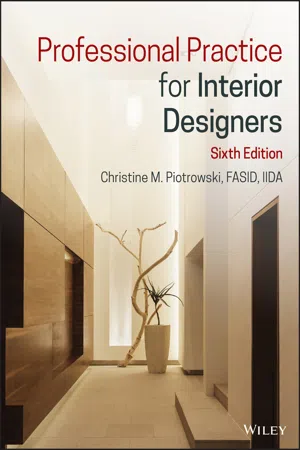
- English
- ePUB (mobile friendly)
- Available on iOS & Android
Professional Practice for Interior Designers
About this book
The leading guide to the business practice of the interior design profession, updated to reflect the latest trends
For nearly thirty years, Professional Practice for Interior Designers has been a must-have resource for aspiring designers and practicing professionals. This revised and updated Sixth Edition continues to offer authoritative guidance related to the business of the interior design profession—from the basics to the latest topics and tools essential for planning, building, and maintaining a successful commercial or residential interior design business.
Filled with business tips and best practices, illustrative scenarios, and other pedagogical tools, this revised edition contains new chapters on interior design in the global environment, building client relationships, and online marketing communications. The author also includes updated information on web and social media marketing, branding, and prospecting for global projects. Recommended by the NCIDQ for exam preparation, this Sixth Edition is an invaluable resource for early career designers or those studying to enter the profession. This important book:
- Contains three new chapters that focus on client relationships, marketing communications, and interior design in the global marketplace.
- Includes new or updated sections that reflect the recent trends related to social media, branding, sustainable design practice and more
- Offers invaluable pedagogical tools in every chapter, including chapter objectives and material relevant for the NCIDQ
- Instructors have access to an Instructor's Manual through the book's companion website
Frequently asked questions
- Essential is ideal for learners and professionals who enjoy exploring a wide range of subjects. Access the Essential Library with 800,000+ trusted titles and best-sellers across business, personal growth, and the humanities. Includes unlimited reading time and Standard Read Aloud voice.
- Complete: Perfect for advanced learners and researchers needing full, unrestricted access. Unlock 1.4M+ books across hundreds of subjects, including academic and specialized titles. The Complete Plan also includes advanced features like Premium Read Aloud and Research Assistant.
Please note we cannot support devices running on iOS 13 and Android 7 or earlier. Learn more about using the app.
Information
PART 1
The Profession
CHAPTER 1
Interior Design asa Profession
- Discuss why the study of professional practices is important to any entry‐level designer.
- Explain how interior design is different from decorating as if you were talking to a client.
- Identify the characteristics of a profession.
- Explain how these characteristics relate to the practice of interior design.
- How would you define the interior design profession?
- Understand the history of the profession in order to learn about the professional practice of interior design.
- Explain how the Great Depression of 1929 affected the interior design professional.
- Name the organizations that became the American Society of Interior Designers and International Interior Design Association.
- Identify key changes that led to the increasing professionalism of interior design.
- Compare the practices of residential interior design and commercial interior design.
- Explain how the section on the business of interior design affects your understanding of the profession as a whole.
- Discuss how interior design provides value to a residential client and a small business owner.
- Explain why professional and social responsibility activities are important to the interior designer and the profession.
- Name three ways in which you will give back to the profession after you begin practice.
- Discuss why an interior designer should consider public service through pro bono work or other contributions.
WHY STUDY PROFESSIONAL PRACTICE?
WHAT IS A PROFESSION?
Interior Design Divisions
Table of contents
- Cover
- Table of Contents
- PREFACE
- ACKNOWLEDGMENTS
- PART 1: The Profession
- PART 2: Career Paths
- PART 3: Professional Responsibility
- PART 4: Defining the Project
- PART 5: Project Delivery
- PART 6: Establishing an Interior Design Practice
- PART 7: Marketing for Success
- PART 8: Managing an Interior Design Practice
- APPENDIX: CIDQ Definition of Interior Design
- GLOSSARY
- GENERAL REFERENCES
- INDEX
- End User License Agreement